ISSN 2410-5708 / e-ISSN 2313-7215
Year 9 | No. 24 | p. 109-119 | February - May 2020
© Copyright (2020). National Autonomous University of Nicaragua, Managua.
This document is under a Creative Commons
Attribution-NonCommercial-NoDerivs 4.0 International licence.
Biocidal activity of soursop extracts (Annona muricata L.) in larval stage III of the Aedes aegypti L. mosquito
https://doi.org/10.5377/torreon.v9i24.9721
Submitted on February 13th, 2020 / Accepted on February 24th, 2020
B.A. Nohemí Carballo Castillo
Thesis specialists
Biotechnology Laboratory, UNAN-Managua
B.A. Diana Bermúdez Hernández
Thesis specialists
Biotechnology Laboratory, UNAN-Managua
M.Sc. Samantha Miranda Calero
Researcher
Biotechnology Laboratory, UNAN-Managua
Ph.D. Martha Lacayo Romero
Researcher
Biotechnology Laboratory, UNAN-Managua
Keywords: Soursop, Annona muricata L., Aedes aegypti L., larvicidal, seed
Abstract
Currently, the mosquito (Aedes aegypti) is the main vector for the transmission of infectious disease viruses with high pathogenic reactivity such as dengue, chikungunya, and zika, which combined with high-risk factors or little medical attention, can be lethal. Additionally, health systems are facing a rising problem, the lack of a control method for this mosquito that is easily proliferated and exhibit increased resistance to traditionally insecticides, reducing the available options for its eradication. This research evaluated the larvae activity of soursop leaf and seed extracts (Annona muricata L.) obtained by two extraction methods (Soxhlet and idle) as an alternative to larval stage III of A. aegypti control. Also, we evaluated the effect of the solvent and the environmental conditions on larvae mortality. The results have shown that the differences in the proximal composition of the samples are dependent not only on the matrix (leaf or seed) used but also on their origin. Likewise, the larvicidal effect of seed and leaf extracts of soursop on larval stage III of A. aegypti is confirmed; however, the effectiveness of the extract is dependent on the extraction method. Controls indicated that the environment and the solvent did not influence when assessing lethality.
INTRODUCTION
In Nicaragua as of 2013, there has been an increase in the rates of people affected by the Aedes aegypti L. mosquito, constituting one of the main public health problems in the country due to the arbovirosis transmitted by this mosquito, such as dengue, zika, chikungunya and yellow fever (Alfaro J., 2017).
The World Health Organization (WHO) has regulated various measures for the control of this vector, among which is the use of chemicals applied in the different phases of its cycle, including Temephos (Abate®) in larval stage and cypermethrin in an adult state through a specialized technique named special spray.
Currently, the main problem with the use and excessive practice of these compounds is the increase in the environmental pollution in addition to the increasing resistance of this organism to the use of Abate®, allowing the mosquito to develop its entire cycle (Castillo J. y Ramos J., 2016).
For the aforementioned, it is necessary to evaluate new options for vector control that generate a lower environmental impact, represent a lower risk to human health and reduce the generation of resistance. Among these potential new alternatives is soursop (Annona muricata L). This plant species has nutritional, medicinal and industrial importance associated with the active compounds present in all parts of the plant, among which acetogenins stand out, metabolites to which its bioinsecticide and pesticide properties are attributed.
The present study carried out the proximal characterization of the samples used to obtain extracts and evaluated the potential of the leaf and seed of the national soursop in a laboratory scale for the control of the third larval stage of A. aegypti to determine dose effective that the organism under study does not tolerate from the immature cycle. This process was carried out by establishing toxicity tests (bioassays) to determine the biocidal potential of the extracts obtained by the extraction methods: rest and Soxhlet.
MATERIALS AND METHODS
Sample collection
Twenty soursop fruits were collected in the Managua trade (Mercado Oriental and Mercado Mayoreo). The samples were disinfected, transported and processed in the Biotechnology Laboratory of UNAN-Managua under controlled conditions to prevent their degradation. The seeds were extracted from the fruit, washed with drinking water and distilled water, dried at room temperature for 7 days and in a convection oven at 40°C for 24 hours, then the sample was homogenized in a RETSCH mill with pore size 0.5 mm The flour obtained was stored in amber airtight containers at 4°C.
The leaves used in the study were obtained from 5 trees of the Technological Development Center (CDT) Campos Azules taking into account their phytosanitary conditions. A representative amount of leaves (approximately 100) was randomly selected from each tree, taking into account their age and quality (free of pests or diseases).
Morphological characterization of the samples
The fruits, seeds, and leaves were characterized using the morphological markers established by Bioversity International and CHERLA (2008) for soursop. Some of the parameters for fruit, leaf, and seed were: length, diameter, the weight of the fruit, weight of seeds, as well as anatomical characteristics shell (exocarp), the pulp (mesocarp).
Determination of the proximal content of the seed
The chemical composition was obtained using methodologies established by the AOAC. The determination of humidity, ash and ethereal extract were performed according to AOAC 925.1, AOAC 923.03 and AOAC 920.39, respectively. All analyses were performed in triplicate with negative controls (white) and internal quality controls. The data obtained were evaluated to determine their reproducibility and accuracy.
Preparation of extracts
After the characterization of the fruit, its seeds were extracted and transformed into flour and the sample was homogenized, of which 25 g was used for each extract. In the same way, the leaves were transformed into flours and of the final homogenized weight 25 g were used for each extract produced.
The extracts evaluated were prepared by idling and Soxhlet methods in triplicate. In the idle method, the flour was placed in amber glass bottles with the solvent (96% ethanol) and remained for 7 days at room temperature. It was subsequently filtered until the solution was obtained and stored in amber bottles at 4°C.
For the Soxhlet method, the flour was placed in a hemicellulose thimble inside the Soxhlet equipment and extracted with the solvent (96% ethanol) in different periods due to the difference in the oily nature of the matrices. In the leaf matrix, the extraction time was 8 hours, while in seeds the extraction took 16 hours. Subsequently, the extracts obtained were stored in dark bottles at 4°C.
Breeding foot of the specimen under study
To guarantee the identity of the mosquito, the larvae eggs were obtained at the National Health Complex Concepción Palacios, where they are selected according to their morphological characteristics. Five egg masses of approximately 100 individuals (totaling 500 individuals) were hatched for the reproduction process in the Biotechnology Laboratory of UNAN-Managua under controlled conditions (temperature of 27°C to 30°C and one of relative humidity of 70 %).
From the first stage, they were provided with food and replaced every three days, as was the water due to the exposed waste (molts). Once the larval phase is over, they go to the pupa state and remain without food for 2 days, during this phase they were protected in an entomological chamber, waiting for the hatching of the adult mosquitoes that were used as progenitors for the creation of the necessary breeding ground for the realization of the bioassays
Design and conditions of bioassays
Two bioassays were designed. In the first bioassay, completely randomized design with a factorial arrangement of treatments was used, where the factors evaluated were matrix (leaf and seed extracts), types of extraction methods (idle and Soxhlet) and concentration of A. muricata extracts (100, 750, 150, 3000, 5000 ppm). For each combination of treatments, five containers were used as repetitions containing 10 individuals of A. aegypti in III larval stage. Mortality readings were recorded every 8 hours (08h, 16h, 24h, 32h, 40h, and 4h) after the exposure of the treatments. Individuals were fed only once during the evaluation period.
In parallel, in the second bioassay, a completely randomized design was used to check the effect of controls: negative control (water), positive control (Abate®) and reactive control (96% ethanol), on the mortality of individuals. Both the number of repetitions (and the number of individuals per container) as the measurement times were the same as those used in the bioassay.
The temperature and pH of the media were continuously monitored, as well as the temperature and relative humidity of the environment to know the relationship between the parameters: relative humidity and environment temperature, as well as the pH and conductivity of the media to know its effect on the results obtained.
Data processing and analysis
To know the effect of the concentration of extracts, the extraction method and the matrix on the percentage of mortality of individuals of A. aegypti, a generalized linear mixed model with a binomial error function was used. The above factors were considered fixed-effect factors, and the measurement time factors and repetitions as random effect factors.
The complete model consisted of the adjustment of main effects and interactions. In all cases, after adjusting the complete model, the non-significant terms were removed step by step and the sub-models were compared using the likelihood ratio test and the Akaike information criterion (AIC) as a measure to compare the adjustment of the different models. The model with the lowest AIC was considered to be the most parsimonious model. Due to the presence of overdispersion in the fitted model, a synthetic variable (modeled as a random effect factor) that captures the over-dispersion present was included.
To verify the effect of controls on the percentage of mortality of individuals of A. aegypti, a generalized mixed linear model with a binomial error function was used. The solvent extraction factor was considered a fixed effect and the measurement time factors and repetitions were considered random effect factors. Due to the presence of overdispersion in the adjusted model, a synthetic variable (modeled as a random effect factor) that captures the over-dispersion present was included. Multiple comparisons were made using the honest Tukey test. All analyses were performed with the R statistical software (R Core Team, 2019).
RESULTS AND DISCUSSION
Proximal composition
The dry matter of the leaf was 90.46 (± 0.10%) and in 96.16 seed (± 0.07%), therefore the moisture content determined was variant for both matrices (9.54 ± 0.10% in leaf and 3.84 ± 0.07% in seeds). This is very useful to determine the stability of the matrices under study. On the other hand, the ash content presented an average leaf value of 8.38 ± 0.13% and 1.43 ± 0.006% in seeds. As for the ethereal extract, the seed had a higher content (32.46 ± 0.06%) concerning the leaf (3.86 ± 0.01%) (Figure 1).
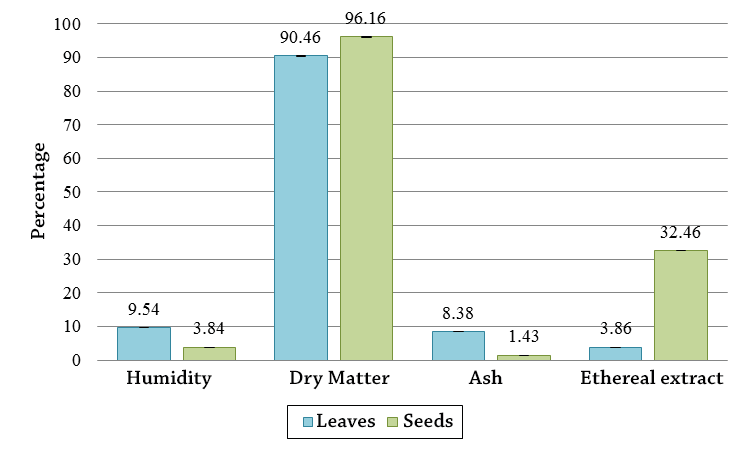
Figure 1. Moisture content, dry matter, ash and ethereal extract of A. muricata samples.
When contrasting the results specified in the proximal composition of the leaf concerning what is established by Neck et al. (2017) similarity was found in the ash content (8.71%) while there is the divergence in the ethereal extract (8.48%) and humidity (2.74%) established in this reference.
On the other hand, in the comparison of international references of the soursop seed composition, we find the values of ashes presented in great similarity to those described by Vit et al. (2014) in Venezuela (1.44%) and differs from that established by Fasakin et al. (2007) in Nigeria (2.29%). The content of ethereal extract determined by Vit et al. (2014) (25.75%) is similar to that described by Fasaki et al. (2007) (22.57%), however, they differ concerning the results affected in this study (32.46%). The national seed also reports higher dry matter content than obtained by Vit et al. (2014) (90.13%).
The variation in the proximal content of the matrixes is associated with the edaphoclimatic conditions in which the plant develops. Similarly, the variety of soursop (acidic, sub-acidic or sweet), is an aspect that has not been explored to date and that can contribute significant differences in the composition of the samples under study. Table 1 details the organoleptic classification of the fruit samples that were incorporated into this investigation.
Table 1. Organoleptic characterization of the soursop fruit samples used.
|
Amount of fruits |
Flavor |
Texture |
Color |
|
14 |
Sweet |
Creamy |
Brown |
|
Watery |
Gray |
||
|
3 |
Acid |
Creamy |
Brown |
|
3 |
Sub acid |
Creamy |
Brown |
Evaluation of the lethality of ethanol extracts according to the extraction method and matrix.
The effect of the concentration of ethanolic extracts of A. muricata on larval mortality varies according to the extraction method (P < 0.05) (Figure 2). Thus, the concentrations of 750 and 1500 ppm obtained by the Soxhlet method have a higher lethality than those obtained by the resting method (P=0.002 and P=0.004, respectively). The remaining concentrations affected mortality regardless of the extraction method. On the other hand, no effect of leaf and seed extracts (matrix) on the mortality of individuals was found.
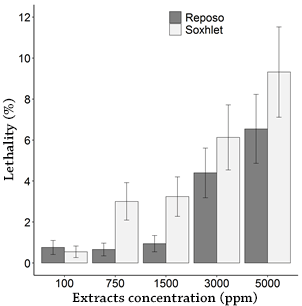
Figure 2. Average larval mortality (± 1 standard error) depending on the concentration of A. muricata extracts and the extraction method.
Effect of controls on mortality
The concentration is chosen in the reactive control (ethanol) was defined based on the highest concentration used in the extracts (5000 ppm). The percentage of mortality of the ethanol reactive control was 1.1%% (Figure 3), thus verifying that the mortality recorded in the bioassay with the ethanolic extracts of leaves and seeds of A. muricata is mainly due to active compounds that directly influence the larval death of A. aegypti.
The organophosphorus insecticide (Abate®) used as a positive control reached a mortality rate of 5.0%. The dose delivered (0.01562 g / 100 ml) was made based on WHO recommendations. The negative control (water) presented 0.2% mortality during the bioassay, where 100 individuals were exposed to this control and only 3 of them were recorded dead. These mortality values are possibly due to the susceptibility associated with the larval density experienced by individuals during the reproduction process, as defined (France A. and Maciá A., 2011).
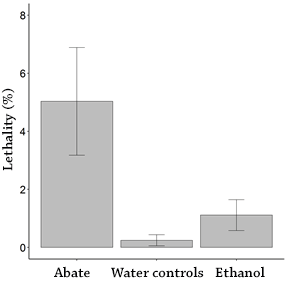
Figure 3. Average larval mortality (± 1 standard error) depending on the controls.
Effect of the physical parameters of ethanol extracts on larval mortality
The temperature and pH of the ethanol extracts were evaluated to monitor the development and survival conditions of the larvae. The temperature is one of the factors on which the larvae of A. aegypti depend, their transfer to the pupal stage is interrupted if they are at a temperature below 13°C, these organisms are resistant to temperatures between 10 to 45°C, however, optimal temperature ranges for larval development have been raised and range from 25 to 29°C (Eiman et al., 2016).
The average values obtained reflect that the temperature ranges of the extracts ranged from 20.5 to 27°C for the leaf and seed matrixes. The readings of these parameters made at 8-hour intervals during the bioassay evaluation behaved stably (Figure 4).
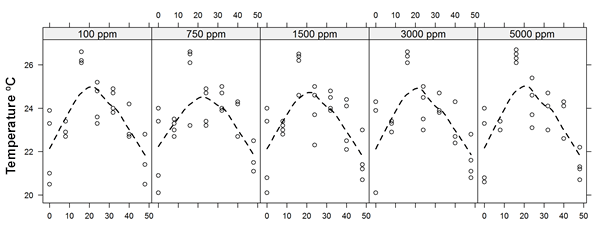
Figure 4. Temperature of the medium at each concentration of A. muricata during the bioassay. The dotted line represents a locally weighted regression (LOESS).
The pH influences larval growth. Díaz et al. (2015) describes that the level of tolerance to acidity ranges is dependent on the larval stage. The acidic pH of 3.5 directly influences increasing mortality rates in larvae of stage I, and is reduced in larvae of stage IV. The pH values during the bioassay presented a wide range (5-7), both for leaves and seeds, however, these do not significantly affect larval mortality considering that the lowest range reported was 5.0.
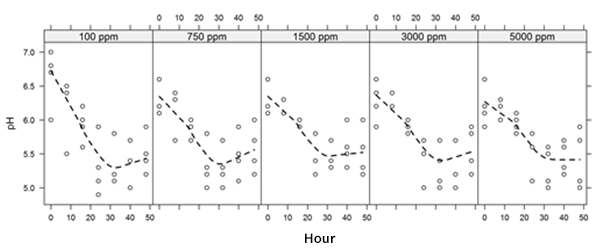
Figure 5. pH values of the medium in each concentration of A. muricata during the duration of the bioassay. The line dotted represents a locally weighted regression (LOESS).
Effect of environmental conditions on larval mortality
The temperature and relative humidity are other factors that can influence the development of A. aegypti in the aquatic phase until its adult state. Various international references describe ranges of varying temperatures and humidity, from 22 to 27°C and 75-80% (Quispe et al., 2014). The values of temperature and relative humidity reported in the bioassay show decrease and increase of values between the assigned areas, this is due to the reading period between (day/night), however, they are within the ranges reported for the development of the larvae.
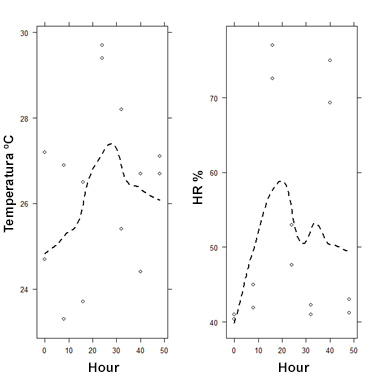
Figure 6. Temperature and relative humidity during the bioassay. The dotted line represents a locally weighted regression (LOESS).
CONCLUSIONS
The results allowed us to identify that the differences in the proximal composition of the samples are dependent not only on the matrix (leaf or seed) but also on their origin. Likewise, the larvicidal effect of soursop and seed extracts on larval stage III of Aedes aegypti is verified, although its effectiveness is dependent on the extraction method. The results obtained for the reactive control (ethanol) reflected that the mortality recorded in the bioassay is mainly due to active compounds present in the extracts. Additionally, the parameters evaluated in the media and in the environment are within the ranges suggested for bioassays with A. aegypti, not interfering with the larval mortality.
THANKS
Special thanks to the Fund for Research Projects (FPI) of the Universidad Nacional Autónoma de Nicaragua, Managua (UNAN-Managua) for financing the resources required to carry out this project. Similarly, the MSc is thanked. Emperatriz Lugo and the National Health Complex Concepción Palacios for her invaluable contribution in providing the eggs of the specimens for the development of this research.
Works Cited
Alfaro, J. (2017). Caracterización epidemiológica de la epidemia de dengue en el distrito seis de Managua Nicaragua 2015, Monografía Universidad Nacional Autónoma de Nicaragua. P. 86.
Castillo, J y Ramos J. (2016). Evaluación de la eficacia temefos (Abate®) en condiciones de laboratorio y su utilidad en el control de larvas de Aedes aegypti, vector del dengue y Chikungunya en el barrio Bóer. Monografía Universidad Nacional Autónoma de Nicaragua.
Cuello M, Jaramillo G, Canchingre E, Pérez J, Castro C, Cabrera O. (2017). Determinación de componentes nutricionales presentes en las hojas secas de Annona muricata L. (guanábana). Revista Cumbres. 2017; 3(1): 09-28.
Eiman M., Introini M., Ripoll C. (2016). “Directrices para la prevención y control de Aedes aegypti”. Ministerio de Salud de la Nación Av. 9 de Julio 1925 (C1073ABA), Cdad. Autónoma de Bs. As., República Argentina.
Fasakin A., Fehintola E., Obijole O., Oseni O. (2007). Compositional analyses of the seed of sour sop, Annona muricata L., as a potential animal feed supplement. Scientific research and essays 3(10):521-523.
Francia, A. y Maciá, A. (2011). Efectos de la competencia larval en los mosquitos de contenedores artificiales, Aedes aegypti y Culex pipiens (Diptera: Culicidae) en condiciones semi-controladas. Revista de la Sociedad Entomológica Argentina, 70 (3-4), 305-315.
Quispe E., et al. (2014). Ciclo biológico y Tabla de Vida de Aedes aegypti, en laboratorio: Trujillo (Perú), 2014. Revista Científica de Estudiantes. REBIOLEST 2015; 1(3): e47.
R Core Team. (2019). R: A language and environment for statistical computing. R Foundation for Statistical Computing, Vienna, Austria. URL https://www.R-project.org/.
Vit P., Santiago B. y Pérez Pérez E. M. (2014). Composición química y actividad antioxidante de pulpa, hoja y semilla de guanábana (Annona muricata L.). Interciencia, 39(5), 350-353.